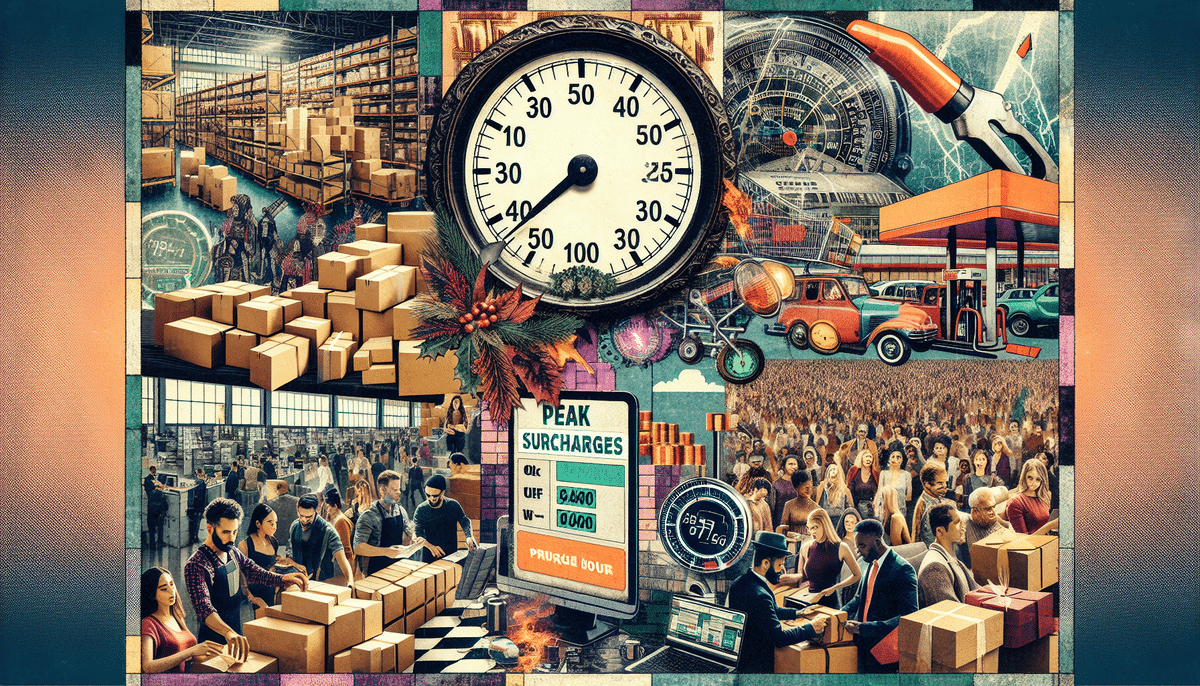Peak Surcharges Explained: What You Need to Know
Peak surcharges are additional fees that companies impose during certain times of the year or under specific circumstances. These surcharges are prevalent in industries such as transportation, delivery, hospitality, and retail. By understanding peak surcharges and their effects, individuals and businesses can better prepare for and mitigate their impact.
What are Peak Surcharges and Why Do They Exist?
Peak surcharges are extra fees charged by companies when demand exceeds normal levels. These higher fees incentivize customers to shift their demand to off-peak times, thereby preventing the overloading of systems and resources. While the specifics of peak surcharges vary across industries, they typically align with seasonal demands, holidays, or emergency situations.
Peak surcharges have been a long-standing practice, but their prevalence has increased with the rise of e-commerce and online shopping. The convenience of shopping at any time of the day has led to higher demand during peak hours, necessitating the implementation of these surcharges.
Although peak surcharges may not always be popular with customers, they are essential for companies to maintain service quality and prevent disruptions. Without these fees, companies might struggle to handle increased demand, leading to delays, cancellations, and dissatisfied customers. Consequently, peak surcharges help companies balance their resources, ensuring reliable and efficient services.
According to a Statista report, global e-commerce sales have been steadily increasing, highlighting the growing necessity for businesses to manage peak demand periods effectively.
Understanding the Factors that Trigger Peak Surcharges
Peak surcharges are typically triggered by factors that cause a significant increase in demand. Key factors include:
- Seasonal Events: Holidays such as Christmas and Thanksgiving, and large events like the Super Bowl or the Olympics, often lead to increased demand.
- Emergency Situations: Natural disasters or unexpected demand surges, such as those experienced during the COVID-19 pandemic, can necessitate additional surcharges.
- Fuel Costs: Fluctuations in fuel prices can impact transportation costs, leading companies to implement surcharges to offset these expenses.
- Regulatory Changes: New government regulations requiring additional safety measures or paperwork can increase operational costs, resulting in peak surcharges.
For instance, during the COVID-19 pandemic, shipping companies saw an unprecedented surge in delivery demand and introduced new surcharges to manage the increased volume effectively.
Rising fuel prices have also prompted transportation companies to adjust their pricing structures. According to the U.S. Energy Information Administration, fluctuations in fuel costs directly impact the operational expenses of shipping and delivery services.
Who is Affected by Peak Surcharges and How?
Peak surcharges impact both consumers and businesses:
- Businesses: Companies that rely heavily on delivery and transportation services may experience increased operational costs. Small businesses, in particular, may struggle to negotiate lower surcharges or switch providers, potentially affecting their profitability.
- Consumers: Higher costs for goods and services during peak periods can lead to increased expenses for consumers. This is especially challenging during holiday seasons when purchasing needs are high.
These surcharges can also have broader economic implications. As businesses face higher transportation and delivery costs, they may increase the prices of their products and services, contributing to inflation. Additionally, increased use of transportation resources during peak times can lead to higher carbon emissions, impacting environmental sustainability.
According to the Environmental Protection Agency, increased transportation activity during peak periods can significantly contribute to carbon emissions, highlighting the environmental implications of peak surcharges.
A Deep Dive into the Types of Peak Surcharges
Peak surcharges vary across different industries, each with its unique approach:
- Transportation Industry:
- Residential Surcharges: Applied to deliveries made to residential addresses, which often require more effort and time compared to commercial deliveries.
- Large Package Surcharges: Charged for packages that exceed specific size or weight thresholds.
- Hospitality Industry:
- Resort Fees: Additional charges added to guests' bills to cover amenities like pool access or gym use.
- Peak Season Rates: Higher room rates charged during busy periods such as holidays or major events.
- Energy Industry:
- Peak Pricing: Higher rates for energy usage during periods of high demand, such as extreme weather conditions, to encourage reduced consumption and prevent blackouts.
- Retail Industry:
- Shipping Surcharges: Additional fees during high shopping periods like Black Friday or Cyber Monday to manage the increased volume of orders.
For example, energy companies often implement peak pricing during extreme weather events to balance supply and demand, as noted in the International Energy Agency's World Energy Outlook 2023.
The Impact of Peak Surcharges on Small Businesses and Consumers
Peak surcharges can significantly affect both small businesses and consumers:
- Small Businesses:
- Higher operational costs due to increased surcharges.
- Limited ability to negotiate better rates with service providers.
- Potential need to pass on additional costs to customers, which may deter purchases.
- Consumers:
- Increased prices for goods and services during peak periods.
- Potential barriers to purchasing, leading to deferred purchases or seeking alternative providers.
These impacts can ripple through the economy, contributing to inflation and affecting purchasing power. Moreover, increased transportation activity can lead to higher carbon emissions, exacerbating environmental concerns.
Research by the Bureau of Labor Statistics indicates that transportation costs are a significant component of overall business expenses, highlighting the financial strain surcharges can impose.
Tips for Mitigating the Cost of Peak Surcharges
Both businesses and consumers can adopt strategies to lessen the impact of peak surcharges:
- For Businesses:
- Plan Ahead: Anticipate peak periods and communicate expected surcharges to customers in advance.
- Negotiate Rates: Work with shipping companies to secure lower surcharge rates.
- Explore Alternatives: Consider alternative shipping methods or providers that offer more favorable rates.
- For Consumers:
- Shop During Off-Peak Times: Take advantage of lower costs by avoiding peak shopping periods.
- Consolidate Purchases: Reduce the number of deliveries by consolidating multiple purchases into a single shipment.
- Seek Alternatives: Use subscription-based services like Amazon Prime that offer flat-rate shipping to minimize surcharge impacts.
The Role of Technology in Managing Peak Surcharges
Advancements in technology have provided businesses and consumers with tools to manage the effects of peak surcharges effectively:
- Delivery Options: Time slot delivery and click-and-collect services allow customers to receive orders at their convenience, reducing the strain on delivery systems.
- Subscription Services: Services like Amazon Prime offer flat-rate shipping, which can help consumers avoid peak surcharges.
- Automation and Optimization: Businesses can use software to optimize delivery routes and schedules, minimizing the need for additional surcharges.
According to a McKinsey report, technological innovations in logistics are crucial for managing increased demand and reducing operational costs.
What to Expect in the Future of Peak Surcharges
As the global economy continues to evolve, peak surcharges are expected to remain a common practice across various industries. Factors influencing their future include:
- Global Economic Trends: Ongoing supply chain disruptions and fluctuating demand levels will likely necessitate the continued use of peak surcharges.
- Technological Advancements: Improved logistics and delivery technologies may offer more efficient ways to manage peak demand, potentially reducing the need for surcharges.
- Consumer Behavior: As more consumers shift to online shopping, companies may develop new strategies to encourage off-peak purchasing, mitigating the impact of surcharges.
Furthermore, environmental considerations may drive companies to find more sustainable ways to handle peak demand, potentially influencing the structure and necessity of surcharges.
Comparing Peak Surcharges Across Industries: Which One is Most Affected?
Peak surcharges impact a range of industries, with the transportation and delivery sector being the most affected. The surge in e-commerce has significantly increased demand for shipping services, prompting many companies to implement additional fees to manage the volume effectively.
The hospitality industry also experiences substantial impacts from peak surcharges, especially during popular holiday seasons like Christmas and New Year. Hotels often increase room rates and may add resort fees, contributing to higher costs for guests.
According to the U.S. Department of Transportation, the transportation sector faces continuous challenges in managing demand fluctuations, highlighting the necessity of peak surcharges to maintain service efficiency.
The Pros and Cons of Implementing Peak Surcharges for Businesses
Implementing peak surcharges presents both advantages and disadvantages for businesses:
- Pros:
- Resource Management: Peak surcharges help manage resources effectively by encouraging demand redistribution to off-peak times.
- Operational Efficiency: Higher fees during peak periods can improve overall service reliability and efficiency.
- Revenue Stabilization: Additional fees can help stabilize revenue during high-demand periods.
- Cons:
- Higher Consumer Costs: Increased prices can lead to negative customer perceptions and reduced sales.
- Competitive Disadvantage: Small businesses may find it challenging to compete with larger companies that can absorb or negotiate lower surcharges.
- Customer Satisfaction: Unexpected or high surcharges can result in customer dissatisfaction and loss of loyalty.
Examining Public Perception: How Do People Feel About Peak Surcharges?
Public perception of peak surcharges is often mixed, with a tendency towards negativity. Many consumers view these additional fees as an unfair way for companies to increase prices without sufficient transparency. This perception can lead to feelings of being misled or deceived.
However, some consumers understand peak surcharges as a necessary mechanism to balance supply and demand, especially during extraordinary circumstances such as natural disasters or pandemics.
A National Public Radio article highlights that transparency and clear communication about the reasons behind surcharges can improve consumer acceptance and reduce negative perceptions.
Strategies for Communicating with Customers about Peak Surcharges
Effective communication is crucial for maintaining customer trust and minimizing misunderstandings related to peak surcharges. Businesses can adopt the following strategies:
- Transparency: Clearly explain the reasons for peak surcharges and how they help maintain service quality.
- Advance Notice: Inform customers about upcoming surcharges during peak periods well in advance.
- Clear Checkout Information: Display surcharge information prominently during the checkout process to avoid surprises.
- Offer Alternatives: Provide options such as choosing off-peak delivery times or alternative shipping methods to help customers minimize surcharge impacts.
Implementing these strategies can enhance customer understanding and acceptance of peak surcharges, fostering better customer relationships.
How Government Regulations Affect the Use of Peak Surcharges
Government regulations play a significant role in shaping how companies implement peak surcharges:
- Disclosure Requirements: In some industries, regulations mandate that companies disclose any additional fees or surcharges, promoting transparent pricing practices.
- Price Caps: Certain governments may impose limits on the amount that companies can charge for peak surcharges, protecting consumers from excessive fees.
- Compliance Costs: New regulations requiring additional safety measures or operational changes can increase costs for companies, leading to the implementation of surcharges.
For example, the Federal Trade Commission in the United States enforces regulations that require clear disclosure of all fees, including surcharges, to ensure fair consumer practices.
Case Studies: Companies that Have Successfully Managed Peak Surcharges
Several companies have implemented peak surcharges effectively, balancing their operational needs with customer satisfaction:
- UPS: During the COVID-19 pandemic, UPS introduced peak surcharges to handle the surge in delivery demand. They also offered discounts to businesses that shifted their deliveries to off-peak times, helping to distribute the demand more evenly.
- Walmart: Walmart launched a subscription-based service that provides unlimited deliveries for a flat annual fee, reducing the impact of peak surcharges for customers and ensuring a steady revenue stream for the company.
These case studies demonstrate that with thoughtful strategies, companies can manage peak surcharges in a way that supports both their operational needs and customer satisfaction.
In conclusion, peak surcharges are additional fees imposed by companies during times of high demand. They affect both businesses and consumers, with a range of positive and negative implications. By understanding peak surcharges and their impacts, individuals and businesses can better prepare and implement strategies to manage these fees effectively, ensuring fair and transparent pricing practices.






















